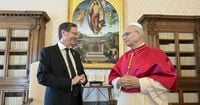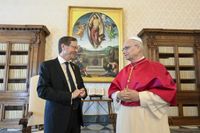In a meeting that underscored both the gravity of the ongoing conflict in the Middle East and the Vatican’s enduring commitment to peace, Pope Leo XIV welcomed Israeli President Isaac Herzog to the Vatican on September 4, 2025. The encounter, held in the pope’s private library, marked the first closed-door audience between the American-born pontiff and Herzog, who has served as Israel’s president since 2021. The significance of the occasion was not lost on either side, as both leaders tackled some of the thorniest issues facing the region today.
According to a detailed Vatican statement released after the talks, the discussions focused squarely on the political and social situation in the Middle East, with a particular emphasis on the war in Gaza. The Vatican reiterated what has become a cornerstone of its diplomatic stance: the two-state solution as “the only way out of the ongoing war.” This message was delivered with unusual clarity and detail, reflecting the urgency the Holy See attaches to the crisis.
Herzog’s visit included meetings not just with Pope Leo, but also with Cardinal Pietro Parolin, the Vatican’s Secretary of State, and Archbishop Paul Gallagher, Secretary for Relations with States. These high-level conversations touched on the need to guarantee a future for the Palestinian people and ensure peace and stability in the region. The Vatican called for a resumption of negotiations, a permanent ceasefire, the release of Israeli hostages, respect for humanitarian law, and the safe entry of aid into Gaza—issues that have repeatedly dominated headlines since the outbreak of war following Hamas’s attack on Israel on October 7, 2023.
The Vatican’s statement, more expansive than the brief communiques usually issued after such meetings, also highlighted the hope that the “legitimate aspirations” of both Israeli and Palestinian peoples could be guaranteed. Reference was made to the situation in the West Bank, the status of Jerusalem, and the delicate relationship between Israeli state authorities and the local Church. The continuing presence of Christian communities throughout the Middle East was also discussed, a concern that has grown as Christian populations in the region have dwindled in recent years.
Herzog, for his part, expressed gratitude for the pope’s “warm welcome” and spoke of a desire to strengthen Israel’s cooperation with the Holy See “for a better future of justice and compassion.” In a statement following the meeting, Herzog noted, “The very fact that Pope Leo XIV, who has only just begun his tenure, received the president of the state of Israel in the Vatican is a very important statement. It reflects the great significance of the relationship between the Holy See and the State of Israel, and of course with the Jewish people, and the importance of the very sensitive issues and challenges we experience today.”
Herzog also underscored Israel’s ongoing efforts to secure the release of hostages taken by Hamas during the October 7 attacks, which saw 251 people abducted and approximately 1,200 killed. While most hostages have since been released during intermittent ceasefires or other deals, around 50 remain in Gaza, with Israeli officials believing that only about 20 are still alive. Herzog emphasized Israel’s commitment to bringing the hostages home and described efforts to facilitate humanitarian aid to Palestinians in Gaza, even as the fighting continues. He also highlighted the rise of antisemitism globally and the importance of protecting Christian minorities in the Middle East—issues that resonate deeply with the Vatican.
The Vatican’s approach to the conflict has been marked by a careful balance. While maintaining its tradition of diplomatic neutrality, the Holy See has repeatedly called for the return of hostages and denounced attacks on civilians in Gaza. Pope Leo’s predecessor, Pope Francis, was particularly outspoken, at times labeling Israel’s actions in Gaza as “immoral” and disproportionate, and even calling for an investigation into whether they constituted genocide. Israel has vehemently denied such accusations, insisting it targets militants and does everything possible to spare civilians, while blaming Hamas for operating in densely populated areas.
Pope Leo, who assumed the papacy in May 2025 as the first American to hold the office, has adopted a somewhat more restrained tone than Francis, though he has not shied away from criticism. He has called for ceasefires, the release of hostages, dignified humanitarian aid, and full respect for international law. In July 2025, following an Israeli shelling incident that killed three people and wounded a priest at the only Catholic church in Gaza, Pope Leo spoke directly with Israeli Prime Minister Benjamin Netanyahu, underscoring the Vatican’s concern for the safety of Christian communities and civilians alike.
The Vatican’s diplomatic efforts extend beyond the immediate crisis in Gaza. Its longstanding support for a Palestinian state and its advocacy for an international status for the city of Jerusalem remain central to its vision for peace. The Latin patriarch, Cardinal Pierbattista Pizzaballa, who oversees Catholics in Israel, Gaza, and the West Bank, has been outspoken about the dangers facing Christian communities, particularly in the face of attacks by Israeli settlers. During a July visit to Taybeh in the West Bank, Pizzaballa and other Church leaders accused Israeli authorities of “facilitating and enabling” such attacks, highlighting the complex web of grievances that must be addressed if peace is to be achieved.
The meeting was not without its diplomatic hiccups. Just two days before the audience, Herzog’s office claimed the visit came at Pope Leo’s invitation. The Vatican quickly contradicted this, clarifying that while it is customary to agree to requests for audiences from heads of state, it does not extend invitations. The episode served as a reminder of the sensitivities that often accompany high-level diplomacy in the region.
Despite these tensions, the tone of the meeting was one of cautious optimism. Both sides recognized the sensitive nature of the current regional challenges and the importance of mutual diplomatic relations. The Vatican’s unusually detailed statement after the meeting signaled a desire to keep the conversation going—not just between Israel and the Holy See, but among all stakeholders committed to peace in the region.
As the world watches the Middle East with a mix of hope and apprehension, the Vatican’s message is clear: only through courageous decisions, goodwill, and the support of the international community can the cycle of violence be broken. The call for a two-state solution, permanent ceasefire, and respect for humanitarian law remains as urgent as ever.
The historic meeting between Pope Leo XIV and President Isaac Herzog may not have produced immediate breakthroughs, but it offered a rare moment of dialogue at the highest level—a reminder that even in the darkest of times, the door to peace is never fully closed.


